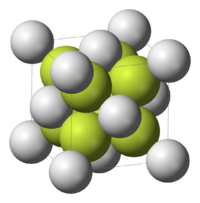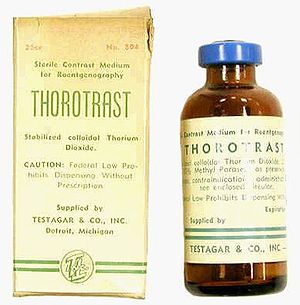
Thorotrast
Encyclopedia


Suspension (chemistry)
In chemistry, a suspension is a heterogeneous fluid containing solid particles that are sufficiently large for sedimentation. Usually they must be larger than 1 micrometer. The internal phase is dispersed throughout the external phase through mechanical agitation, with the use of certain...
containing particles of the radioactive compound thorium dioxide
Thorium dioxide
Thorium dioxide , also called thorium oxide is a white, crystalline powder. It was formerly known as thoria or thorina. It is produced mainly as a by-product of lanthanide and uranium production.[1]...
, ThO2, used as a contrast medium
Contrast medium
A medical contrast medium is a substance used to enhance the contrast of structures or fluids within the body in medical imaging...
in X-ray
X-ray
X-radiation is a form of electromagnetic radiation. X-rays have a wavelength in the range of 0.01 to 10 nanometers, corresponding to frequencies in the range 30 petahertz to 30 exahertz and energies in the range 120 eV to 120 keV. They are shorter in wavelength than UV rays and longer than gamma...
diagnostics in the 1930s and 40s (use in some countries, such as the U.S.
United States
The United States of America is a federal constitutional republic comprising fifty states and a federal district...
, continued into the 1950s).
The naturally abundant thorium nuclide 232Th is slightly unstable and decays through the emission of an alpha particle
Alpha particle
Alpha particles consist of two protons and two neutrons bound together into a particle identical to a helium nucleus, which is classically produced in the process of alpha decay, but may be produced also in other ways and given the same name...
. Thorium compounds produce excellent images because of thorium's high opacity to X-rays (it has a high cross section
Cross section (physics)
A cross section is the effective area which governs the probability of some scattering or absorption event. Together with particle density and path length, it can be used to predict the total scattering probability via the Beer-Lambert law....
for absorption). Because the suspension offered high image quality and had virtually no immediate side-effects compared to the alternatives available at the time, Thorotrast became widely used after its introduction in 1931. (António Egas Moniz contributed to its development.). About 2 to 10 million patients worldwide have been treated with Thorotrast.
Safety
Even at the time of introduction, there was concern about the safety of Thorotrast. Following injection, the drug is distributed to the liverLiver
The liver is a vital organ present in vertebrates and some other animals. It has a wide range of functions, including detoxification, protein synthesis, and production of biochemicals necessary for digestion...
, spleen
Spleen
The spleen is an organ found in virtually all vertebrate animals with important roles in regard to red blood cells and the immune system. In humans, it is located in the left upper quadrant of the abdomen. It removes old red blood cells and holds a reserve of blood in case of hemorrhagic shock...
, lymph node
Lymph node
A lymph node is a small ball or an oval-shaped organ of the immune system, distributed widely throughout the body including the armpit and stomach/gut and linked by lymphatic vessels. Lymph nodes are garrisons of B, T, and other immune cells. Lymph nodes are found all through the body, and act as...
s, and bone
Bone
Bones are rigid organs that constitute part of the endoskeleton of vertebrates. They support, and protect the various organs of the body, produce red and white blood cells and store minerals. Bone tissue is a type of dense connective tissue...
, where it is absorbed. After this initial absorption, redistribution takes place at a very slow pace. Specifically, the biological half-life
Biological half-life
The biological half-life or elimination half-life of a substance is the time it takes for a substance to lose half of its pharmacologic, physiologic, or radiologic activity, as per the MeSH definition...
is estimated to be 22 years. This means that the organs of patients who have been given Thorotrast will be exposed to the high ionizing alpha-radiation it emits for much of the rest of their lives. The significance of this long-term exposure was not fully understood at the time of Thorotrast's introduction in 1931.
Due to the release of alpha particles, Thorotrast was found to be extremely carcinogenic. There is a high over-incidence of various cancers in patients who have been treated with Thorotrast. The cancers occur some years (usually 20-30) after injection of Thorotrast. The risk of getting liver cancer
Hepatocellular carcinoma
Hepatocellular carcinoma is the most common type of liver cancer. Most cases of HCC are secondary to either a viral hepatitide infection or cirrhosis .Compared to other cancers, HCC is quite a rare tumor in the United States...
(or bile duct cancer
Cholangiocarcinoma
Cholangiocarcinoma is a cancer of the bile ducts which drain bile from the liver into the small intestine. Other biliary tract cancers include pancreatic cancer, gallbladder cancer, and cancer of the ampulla of Vater...
) in former Thorotrast patients has been measured to be well above 100 times the risk of the rest of the population. The risk of leukemia
Leukemia
Leukemia or leukaemia is a type of cancer of the blood or bone marrow characterized by an abnormal increase of immature white blood cells called "blasts". Leukemia is a broad term covering a spectrum of diseases...
appears to be 20 times higher in Thorotrast patients. German patients exposed to Thorotrast had their median life-expectancy shortened by 14 years in comparison to a similar non-exposed control group.
The Danish
Denmark
Denmark is a Scandinavian country in Northern Europe. The countries of Denmark and Greenland, as well as the Faroe Islands, constitute the Kingdom of Denmark . It is the southernmost of the Nordic countries, southwest of Sweden and south of Norway, and bordered to the south by Germany. Denmark...
director Nils Malmros
Nils Malmros
Nils Malmros , a Danish film director and screenwriter, is considered a leading auteur of realism in Danish cinema. Malmros is noted for his detailed focus on the common growing pains of adolescence and the loss of innocence, which he draws from his childhood experiences growing up in Århus, Denmark...
's movie, Facing the Truth (original Danish
Danish language
Danish is a North Germanic language spoken by around six million people, principally in the country of Denmark. It is also spoken by 50,000 Germans of Danish ethnicity in the northern parts of Schleswig-Holstein, Germany, where it holds the status of minority language...
title At Kende Sandheden) from 2002, portrays the dilemma that faced Malmros's father, Richard Malmros, when treating his patients in the 1940s. Richard Malmros was deeply concerned about the persistence of Thorotrast in the body but was forced to use Thorotrast, because the only available alternative (per-abrodil) had serious immediate side-effects, suffered from image quality problems and was difficult to obtain during the Second World War. The use of Thorotrast in Denmark ended in 1947 when safer alternatives became available. Today, iodinated hydrophilic molecules are universally used as contrast agents for X-ray procedures.
Current use
Thorotrast has also been used in research to stain neural tissue samples for examination by historadiographyHistoradiography
Historadiography is a technique formerly utilized in the fields of histology and cellular biology to provide semiquantitative information regarding the density of a tissue sample. It is usually synonymous with microradiography...
.

